Jasper: Types and varieties of Jasper (Photos)
Jasper is an opaque variety of silica with a diverse range of colors and patterns. Jasper is an opaque, fine-grained variety of chalcedony, which itself is a cryptocrystalline form of quartz. This means that jasper is composed of microscopic quartz crystals intermixed with various impurities, which give it its distinctive coloration.
Jasper, a diverse and versatile gemstone, comes in a wide range of types and varieties, each with its unique characteristics and patterns. These include Picture Jasper, known for its landscape-like patterns; Poppy Jasper, featuring vibrant, flower-like designs; Imperial Jasper, characterized by deep, rich colors; Leopard Jasper, with its distinctive spots; Dalmatian Jasper, featuring a spotted pattern; Ocean Jasper, with its ocean-inspired colors; Rainforest Jasper, boasting vibrant, green hues; Mookaite Jasper, known for its colorful patterns; Bruneau Jasper, featuring intricate designs; and Willow Creek Jasper, with its vibrant, colorful patterns, among others.
Properties of Jasper
Composition: Silicon dioxide (SiO₂) with various mineral impurities like iron oxides, clay minerals, and chalcedony. These impurities shape its color and characteristics.
Color: Incredibly diverse! Jasper can be found in vibrant reds, oranges, yellows, greens, browns, blues, and even black. Often multi-colored with intricate banding and patterns.
Luster: Ranges from dull to waxy, depending on the type and density of inclusions. Polished jasper can achieve a beautiful vitreous (glassy) shine.
Crystal System: Microcrystalline, meaning it lacks a defined crystal structure.
Streak: White, like regular quartz.
Hardness: 6.5 to 7 on the Mohs scale, making it a relatively hard and durable stone.
Cleavage: None, unlike most crystalline minerals.
Crystal Form: Typically found as massive, rounded formations or pebbles. Can occasionally form in botryoidal or stalactitic shapes.
Density: 2.5 to 2.9 g/cm³, slightly denser than regular quartz due to the mineral inclusions.
Transparency: Can range from opaque to translucent, depending on the density and type of inclusions. Some varieties, like Moss Agate, can be semi-transparent.
Fracture: Conchoidal, similar to regular quartz, meaning it breaks with smooth, curved surfaces.
Solubility: Insoluble in most common solvents, but can be dissolved in hydrofluoric acid.
Magnetism: Non-magnetic.
Fluorescence: May fluoresce weakly under long-wave ultraviolet light, depending on the type of inclusions.
Pleochroism: Weak, may show slight variations in color intensity depending on the viewing angle.
Refractive Index: 1.53 to 1.58, slightly higher than regular quartz due to the higher density.
Jasper Types and Colors
Jasper is a fascinating gemstone known for its wide range of colors and patterns. While most people associate it with red, the reality is much more diverse. It's important to note that some popular "jaspers" aren't technically true jaspers. Here's an overview of the different types and colors of jasper:
True Jaspers
Red Jasper
 |
| Red Jasper |
Red jasper is an opaque, microcrystalline variety of chalcedony, which is itself a cryptocrystalline form of quartz. Red Jasper obtains its rich red hue from the presence of iron oxides. Its formation often occurs in association with volcanic activity, where iron-rich minerals interact with the surrounding sediments. The color can range from a light pink to a deep, brick red.
Major occurrences of Red Jasper can be found in regions with a history of volcanic activity or sedimentary rock formations. Notable deposits include areas in Australia, India, Brazil, Russia, and the United States.
Yellow Jasper
 |
| Yellow jasper |
Yellow jasper is also an opaque, microcrystalline variety of chalcedony. Yellow Jasper, with its sunny and vibrant yellow coloration, is typically attributed to iron oxide, but in this case, the dominant oxide is limonite or sulfur impurities. It may display variations in shade, from pale lemon yellow to deep golden hues, often accompanied by subtle banding or mottling patterns. Yellow Jasper is found in many locations around the world, including the United States, Australia, and Brazil.
Green Jasper
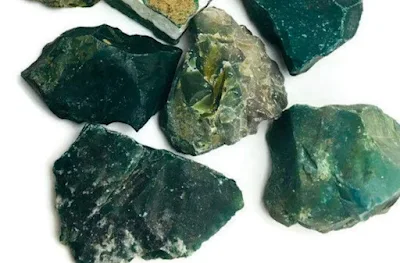 |
| Green Jasper |
Green jasper, like the other varieties, is an opaque, microcrystalline chalcedony. Green Jasper, characterized by its verdant green tones, owes its coloration to various mineral inclusions, such as chlorite, actinolite, or hornblende. The shade of green can vary depending on the specific mineral present and its concentration. It may exhibit swirling patterns, veining, or dendritic formations, adding to its visual appeal. Green Jasper is found in many locations around the world, including the United States, Australia, and Brazil.
Jasper-like Stones
Bloodstone
 |
| Bloodstone |
Bloodstone is a variety of microcrystalline chalcedony characterized by its deep green color with red spots. The green color comes from chlorite, while the red spots are caused by inclusions of hematite. It is often used for jewelry and carvings. Bloodstone is found in many locations around the world, including India, China, and Australia.
Picture Jasper
 |
| Picture Jasper |
Picture jasper, a captivating gemstone with intricate patterns and vibrant colors, Picture jasper is not a true jasper but a microcrystalline quartz like other members of the chalcedony family. Its captivating "picture-like" patterns and images that resemble landscapes or other scenes, make it a sought-after material for jewelry, carvings, and decorative objects. Picture Jasper is found in many locations around the world, including the United States, Mexico, and Russia.
Imperial Jasper
 |
| Imperial jasper |
Imperial jasper is a rare and valuable variety of jasper known for its vibrant green and yellow colors with intricate patterns. While classified as a "jasper," it's not technically a true jasper. Instead, it's a microcrystalline quartz. It is often used for decorative purposes due to its beauty and rarity. Imperial Jasper is found in only a few locations around the world, including Russia and South Africa.
Leopard Jasper
 |
| Leopard Jasper |
Leopard Jasper, stunning for its "spots," isn't a true jasper but a chalcedony formed through a process called orbicularization. It's known for its distinctive "leopard skin" pattern, Minerals like manganese and iron diffuse into a base of silica, forming concentric circles and crystallizing, creating the distinctive pattern. Leopard Jasper is found in many locations around the world, including the United States, Mexico, and South Africa.
Dalmatian Jasper
 |
| Rough and polished Dalmatian jasper |
Dalmatian jasper, despite its name, is not a true jasper. This unique stone is actually a type of igneous rock called perthite. Its distinctive speckled appearance, reminiscent of a Dalmatian dog's coat, is caused by a mixture of minerals within the perthite. The white spots are formed by inclusions of feldspar. The black spots are composed of the rare amphibole arfvedsonite. Dalmatian jasper is primarily found in Mexico, particularly in the Chihuahua and Durango states.
Dalmatian stone has a hardness of 6-7 on the Mohs scale, making it slightly softer than true jasper.
Ocean Jasper
 |
| Ocean jasper |
Ocean jasper is a variety of jasper with swirling patterns and colors reminiscent of the ocean. While commonly referred to as a jasper, Ocean Jasper technically falls under the umbrella of orbicular chalcedony. This means it's composed primarily of microcrystalline quartz with some additional minerals like feldspar and iron oxides.
Kambaba Jasper
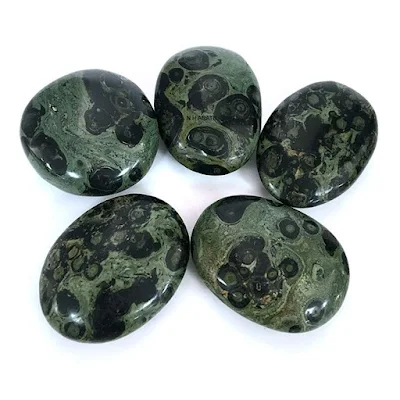 |
| Kambaba Jasper |
Kambaba Jasper, also known as Kabamba Jasper, is a mesmerizing gemstone characterized by its vibrant green background and distinctive black orbs. While often referred to as a "jasper," it's not a true jasper but rather a stromatolite, a fossilized structure formed by blue-green algae in shallow seas millions of years ago. Kambaba Jasper is found almost exclusively in one location: the Bongolava region of western Madagascar. This region boasts several small mines where the stone is extracted.
Mookaite Jasper
 |
| Mookaite Jasper |
Mookaite Jasper is a captivating gemstone known for its unique patterns and vibrant colors. It is known for its reddish-brown to yellow colors with swirling patterns. While often referred to as a "jasper," technically it's a silicified radiolarite, a rock formed from the fossilized remains of microscopic sea creatures called radiolarians. It is often used for jewelry and carvings.
Brecciated Jasper
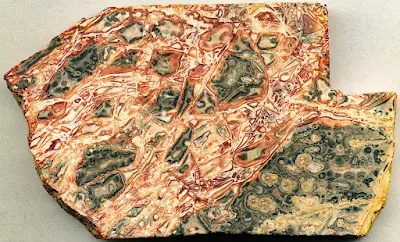 |
Brecciated Jasper |
Brecciated Jasper is a fascinating gemstone characterized by its unique "broken" appearance. It's not a true jasper but rather a breccia, a rock formed from fragments of other rocks cemented together. These fragments can be a variety of minerals, including jasper, chert, quartz, and even fossils. This can result in a variety of colors and patterns depending on the specific types of jasper involved.
Kaleidoscope Jasper
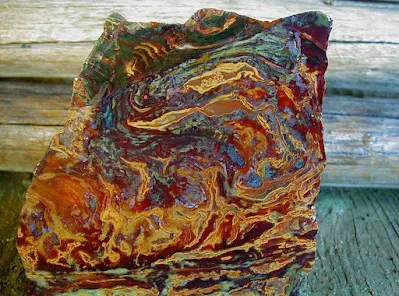 |
| Kaleidoscope Jasper |
Kaleidoscope jasper, despite its name, isn't a true jasper. It's actually a microcrystalline quartz, meaning it's composed of tiny quartz crystals visible under magnification. This unique stone is prized for its captivating colors and swirling patterns resembling a kaleidoscope. It's formed through a complex process involving petrified wood, rhyolitic ash, and various minerals.
Others prefer the term "rhyolite jasper" to emphasize the influence of volcanic ash. Kaleidoscope jasper is found primarily in one location: the Ochoco National Forest in Oregon, USA.
Zebra Jasper
 |
| Zebra Jasper |
Zebra Jasper, despite its name, is not a true jasper but rather a type of chalcedony. This fascinating stone earns its name from its distinctive zebra-like stripes, featuring alternating bands of white, cream, black, or red. The formation of Zebra Jasper involves a process called orbicularization.
Bumblebee Jasper
 |
| Bumblebee Jasper |
Bumblebee Jasper is a unique and captivating gemstone known for its vibrant color combinations and distinctive patterns. Despite its name, it's not a true jasper but rather a carbonate-rich rock with a primarily calcite composition.
See also:
Quartz - Varieties and Types of Quartz (Photos)
Types of Agate With Photos
Types of Opal With Photos

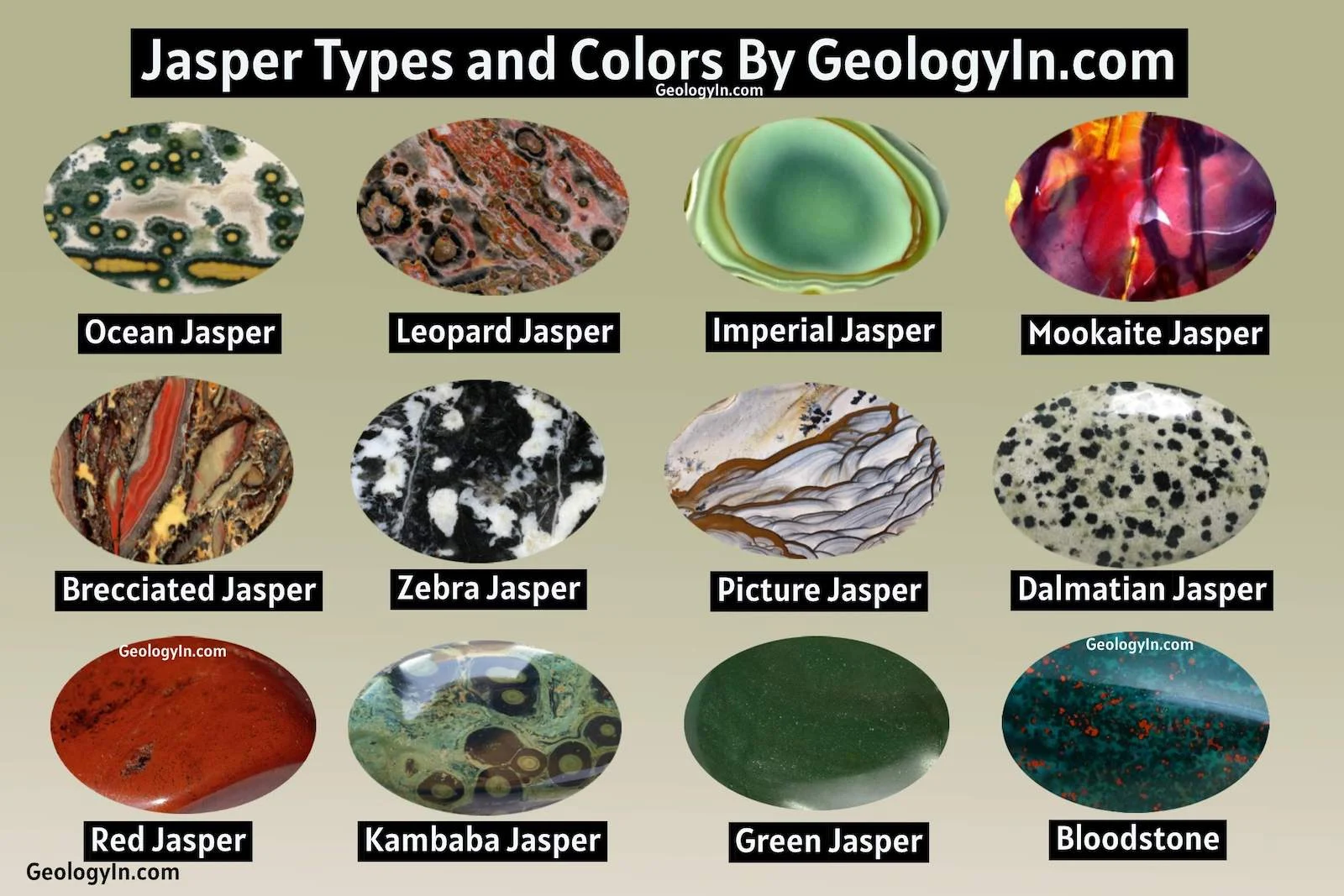
%20(1).webp)






